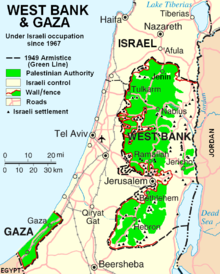Two-state solution


A solution to the Israeli-Palestinian conflict that provides “two states for two ethnic groups” is being discussed as a two-state solution . An independent state of Palestine alongside the state of Israel west of the Jordan is sought. The border between the two states has not yet been finalized, as no agreement has yet been reached and further negotiations are necessary. The Palestinian or Arab side exists as a border on the armistice line that existed until the Six Day War in 1967, but this is not accepted by the Israeli side. According to this variant, the area of the League of Nations mandate for Palestine , which is not part of the state of Palestine envisaged within this solution, is to become Israeli territory.
history
The scope of this dispute resolution proposal is provided by the UN -Resolutionen on 'peaceful settlement of the Palestinian question "( English : Peaceful settlement of the question of Palestine ), which date back to the year 1974th The most recent corresponding resolution of November 24, 2015 was passed with 155 votes in favor, seven against and seven abstentions. There is u. a. speaks of “two states, Israel and Palestine, side by side within secure and recognized borders”. Earlier resolutions also contain the additional passage that “a just solution to the Palestinian refugee issue in accordance with UN resolution 194 must be found”.
The first significant Palestinians have shown interest in a two-state solution since the mid-1970s (in particular Said Hammami , the PLO representative in London). The Palestinian leadership finally took up the concept at the 1982 Arab summit in Fez, Morocco . Nevertheless, Yasser Arafat only recognized Israel - initially only indirectly - from 1988 (speech to the UN General Assembly on December 13, 1988). In 1989 Arafat declared the 1964 PLO charter, which called for the destruction of the State of Israel, to be invalid. And on September 9, 1993, Arafat, as PLO chairman, wrote to the then Israeli Prime Minister Yitzhak Rabin in a historic letter: “The PLO recognizes the right of the State of Israel to exist in peace and security. [The PLO] renounces terror and any other kind of violence ”. In return, Rabin recognized "the PLO as the representative of the Palestinian people".
Many attempts to implement a two-state solution have already been made, starting with the Madrid Conference in 1991, followed by Oslo I in 1993, the Gaza-Jericho Agreement in 1994, Oslo II in 1995, the failed Camp David II meeting in 2000 and the continuation in Taba 2001. In 2002, the Arab League launched the Arab Peace Initiative. From the Sharon Plan of 2004, Ehud Olmert developed the Convergence Plan of 2006. The last attempt, which also failed, was the Israeli-Palestinian peace talks 2013-2014.
Trump plan
In February 2017 it became known that the US government under Donald Trump no longer insists on a two-state solution and leaves it to the conflicting parties themselves how they want to achieve a lasting peace solution. In 2018, Trump decided to move the American embassy in Israel from Tel Aviv to Jerusalem . In the same year, unlike the year before, the US government spoke out in favor of a two-state solution.
On January 28, 2020, Trump presented a two-state solution together with Israeli Prime Minister Benjamin Netanyahu . The government of the Palestinian Territories rejected the proposal in advance.
The cornerstones of the plan are:
- West Bank: The plan provides for the establishment of a Palestinian state that comprises 97 percent of the Palestinians currently living in the West Bank. Overall, the state, including the Gaza Strip, should cover an area that is comparable to the Arab-controlled territory before the Six-Day War of 1967. For this purpose, both sides should exchange land. Israel is allowed to integrate the vast majority of the settlements and the entire Jordan Valley into its national territory. In return, several Arab communities that currently belong to Israel and are located on the western and northwestern edges of the West Bank, e.g. B. Umm al-Fahm , become Palestinian.
- Gaza Strip: The Gaza Strip is to be connected to two small areas in the Negev on the border with Egypt, which Israel will cede to the Palestinians. Among other things, an industrial area can be created here. The Gaza Strip is to be politically returned to the Palestinian government by Hamas.
- Jerusalem: Jerusalem remains the undivided capital of Israel, while Abu Dis, formerly part of Jerusalem, is to become the capital of Palestine.
- Holy places: The status quo on the Temple Mount, which is currently administered by the Jordanian Waqf Authority, is to be preserved. It is demanded that in future people of all faiths should have the opportunity to pray on the Temple Mount, which is currently only allowed to Muslims.
- Infrastructure: The territories of the two states are to be connected by means of a network of roads, bridges and tunnels in order to ensure freedom of movement and reduce checkpoints. A high-speed road is to be built between the West Bank and the Gaza Strip. At the same time, the Palestinian state will have access to the ports in Haifa and Ashdod to handle freight traffic. Five years after the peace plan was signed, consideration could be given to a separate port for Gaza and a small airport.
- Refugees: The conflict created a Palestinian and a Jewish refugee problem. The Arab refugees had been kept in limbo to keep the conflict alive. The plan provides three options for the Arab refugees: admission to the Palestinian state, integration into the Arab host countries or resettlement to other countries of the Organization for Islamic Cooperation. A fund is intended to enable compensation payments. At the same time, Israel must also receive compensation for accepting the Jewish refugees.
- Security: The plan puts security first . The Palestinian state is said to be demilitarized. Israel retains an overarching security responsibility, which includes full control of the airspace west of the Jordan, control of the access roads to the Palestinian territories and building restrictions in the border regions.
- Liberalization: The future Palestinian state should follow a liberal order, i.e. be transparent, guarantee an independent judiciary, human rights, freedom of religion and the press and a democratic system. At the same time, corruption is to be combated, inciting passages in curricula and textbooks to be removed and the payment of pensions to Palestinian terrorists and their families to be stopped.
- Prisoners: The agreement provides for the release of Palestinian prisoners from Israeli prisons, except for convicted murderers. The condition for the release is a commitment to Israel's right to exist and the surrender of all Israelis who are in Palestinian hands .
- Economy: The USA had already presented its economic vision for solving the Middle East conflict in June 2019. The Palestinians are expected to receive around $ 50 billion in economic aid. A free trade area of Palestine with Jordan and the USA is proposed.
- Arab countries: A broader cooperation between Egypt, Jordan and Israel through an organization for security and cooperation in the Middle East is proposed.
Reactions from other states to the proposal varied. Saudi Arabia called on the Palestinians to negotiate on this basis, Egypt saw it as a contribution to stability and security, while Qatar and Jordan emphasized the 1967 borders as the basis for all peace efforts. Many Israeli Arabs are also protesting against the peace plan because they do not want to live in a Palestinian state in the future. This was confirmed by Ayman Odeh , chairman of the Arab party United List , which currently has 13 seats in the Knesset .
See also
Web links
Footnotes
- ↑ Resolution 3236 (XXIX) - The Question of Palestine , United Nations General Assembly , November 22, 1974
- ↑ 70/15. Peaceful settlement of the question of Palestine, November 24, 2015
- ↑ http://www.humanrightsvoices.org/site/documents/?d=13700
- ↑ 61/26. Peaceful settlement of the question of Palestine, December 4, 1996
- ^ Ayoob, Mohammed. The Middle East in world politics. 1981, p. 90.
- ↑ Cesarani, David. The Jewish chronicle and Anglo-Jewry, 1841-1991. 1994, p. 230.
- ^ Tessler, Mark A. (1994): A History of the Israeli-Palestinian conflict , p. 718.
- ↑ Le Monde diplomatique of October 14, 2011, The Promised State, [1] ; accessed on September 7, 2017
- ^ The Palestinian National Charter of July 17, 1968 ; see in particular Articles 9, 10, 15
- ↑ WDR, September 9, 1993 - PLO recognizes Israel's right to exist, [2] ; accessed on September 7, 2017.
- ↑ Sueddeutsche.de: USA no longer insist on two-state solution in the Middle East , February 15, 2017
- ↑ https://de.usembassy.gov/de/eroeffnung-der-us-botschaft-in-jerusalem/
- ^ Marcel Wagner: Paris Middle East Conference. Two-state solution and the Trump factor . In: deutschlandfunk.de , January 15, 2017.
- ↑ ZEIT ONLINE: Middle East conflict: Donald Trump is in favor of a two-state solution . In: The time . September 26, 2018, ISSN 0044-2070 ( zeit.de [accessed January 30, 2020]).
- ↑ zeit.de January 28, 2020: Donald Trump proposes a Palestinian state
- ↑ DER SPIEGEL: Trump proposes a Palestinian state - with East Jerusalem as the capital - DER SPIEGEL - Politics. Retrieved January 28, 2020 .
- ↑ DER SPIEGEL: Donald Trump: Mahmud Abbas rejects peace plan as a "conspiracy" - DER SPIEGEL - Politics. Retrieved January 28, 2020 .
- ↑ This is Trump's “realistic two-state solution”. Israelnetz.de , January 29, 2020, accessed on February 8, 2020 .
- ↑ The Middle East Plan and its Consequences: How Trump's Advance Divides the Islamic World. In: tagesspiegel.de. January 31, 2020, accessed January 30, 2020 .
- ^ Israeli-Arab resistance to Trump. Israelnetz.de , February 3, 2020, accessed on February 9, 2020 .